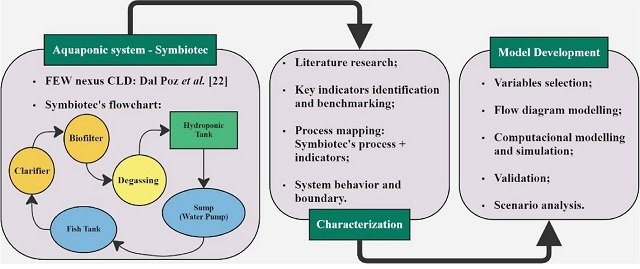
Aquaponics is an integrated production system that has gained significant attention as a sustainable approach to food production. This innovative system not only conserves resources but also reduces water consumption and production costs compared to traditional farming methods and other animal protein production systems.
Researchers from the Swedish University of Agricultural Science (SLU), Symbiotec Aquaculture and Integrated Production Systems Ltda., and the University of Campinas (UNICAMP) published a study in the journal Circular Economy and Sustainability where they analyzed aquaponics systems in terms of the Food-Energy-Water (FEW) nexus, applying a case study on a family farming scale within a delimited area in the green belt of São Paulo. They also analyzed the sustainability of the aquaponics system through System Dynamics Modeling (SDM) simulations for selected socio-economic and environmental parameters.
The Role of Aquaponics in the Food, Energy, and Water Nexus
The integration of aquaponics into the FEW nexus is increasingly recognized as a crucial strategy for sustainable development. The FEW nexus approach, highlighted by the World Economic Forum, emphasizes the interconnectedness of food production, energy consumption, and water use. In the context of aquaponics, this approach facilitates a comprehensive understanding of the trade-offs and synergies involved in transitioning to more sustainable practices, especially in light of climate change.
By leveraging the interdisciplinary and multiscale objectives of the FEW dimensions, aquaponics can contribute to building resilience in food, energy, and water systems. The adoption of aquaponics in urban areas and family farming has shown promising results in improving productivity while minimizing resource inputs. This is particularly relevant in cities like São Paulo, where urban expansion threatens the green belts that are crucial for food production and environmental conservation.
Challenges and Future Directions
Despite the clear advantages, the widespread adoption of aquaponics faces several challenges. The lack of public policies supporting sustainability transitions in aquaponics has hindered its full potential. Current payment schemes for environmental services do not consider aquaponics, nor are there certification processes or government programs dedicated to promoting its products. As a result, the true benefits of aquaponics remain undervalued and underutilized.
To address these challenges, it is necessary to develop robust policy frameworks that recognize and support the contributions of aquaponics to sustainable food production. Additionally, the application of advanced modeling tools like System Dynamics Modeling (SDM) can enhance our understanding of the complex interactions within the FEW nexus, enabling more informed decision-making. Although the use of mathematical models in aquaponics is still in its early stages, their potential to optimize plant and fish growth conditions could further improve the efficiency and sustainability of this system.
System Dynamics Modeling
The researchers developed a System Dynamics Modeling (SDM) approach to analyze the sustainability of aquaponics within the FEW nexus for family farms. SDM is a powerful tool that considers social, economic, and environmental factors to assess the long-term impacts of a system like aquaponics.
The Results: A Sustainable Future for Family Farming
The results of the SDM analysis demonstrated the effectiveness of aquaponics in achieving environmental sustainability within the context of the FEW nexus. This highlights the potential of aquaponics for family farms to produce high-quality food while minimizing their environmental footprint.
Conclusion
“The application of the System Dynamics Modeling tool in the analysis of aquaponics system sustainability for the FEW nexus proved to be robust and efficient for the indicators in question. Therefore, it points to the viability of SDM as a tool to support decision-making and the development of public policies,” the researchers conclude.
Stay Always Informed
Join our communities to instantly receive the most important news, reports, and analysis from the aquaculture industry.
In this sense, aquaponics represents a promising solution for achieving sustainability in food production, particularly when integrated into the broader context of the food, energy, and water nexus. Its ability to conserve resources, reduce environmental impacts, and improve productivity makes it an attractive option for both urban and rural settings. However, to fully harness the potential of aquaponics, there is an urgent need for supportive policies, certification processes, and further research into modeling tools that can optimize and scale this innovative system.
Contact
Erika Cristina Francisco
Department of Energy and Technology, Swedish University of Agricultural Science/SLU
Uppsala, Sweden
Email: erika.francisco@slu.se
Reference (open access)
Francisco, E.C., Freato, T.A., Piolli, A.L. et al. Analysis of the Aquaponic System Sustainability via System Dynamics Modelling – FEW Nexus Approach. Circ.Econ.Sust. (2024). https://doi.org/10.1007/s43615-024-00408-z
Editor at the digital magazine AquaHoy. He holds a degree in Aquaculture Biology from the National University of Santa (UNS) and a Master’s degree in Science and Innovation Management from the Polytechnic University of Valencia, with postgraduate diplomas in Business Innovation and Innovation Management. He possesses extensive experience in the aquaculture and fisheries sector, having led the Fisheries Innovation Unit of the National Program for Innovation in Fisheries and Aquaculture (PNIPA). He has served as a senior consultant in technology watch, an innovation project formulator and advisor, and a lecturer at UNS. He is a member of the Peruvian College of Biologists and was recognized by the World Aquaculture Society (WAS) in 2016 for his contribution to aquaculture.




